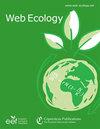热带高原生态系统碳循环:全球综述
IF 2.4
3区 环境科学与生态学
Q2 ECOLOGY
引用次数: 1
摘要
摘要随着栖息地的改变,气候变化对生物多样性产生了深远的影响,并可能改变人类福利所依赖的生态系统服务。许多关于碳循环的研究都集中在低地热带森林;然而,尽管山地森林在固碳方面起着关键作用,但对它们的探索却很少。在这里,我综合了地球热带高地生态系统中碳在不同储量(地上、地下和土壤)以及主要通量(植物分解、呼吸和凋落物)中分配的知识状况。2020年11月,我们通过Google Scholar和Scopus数据库中的关键词组合,对2000年至2020年发表的文献进行了系统综述,从而分析了全球热带高地(23.5°N-23.5°S之间)的书目、地理、方法学和碳循环信息。根据纳入-排除标准对共1967篇文献进行分析后,选取了近20年发表的135篇文献。大多数研究是在南美洲的热带和亚热带湿润阔叶林中进行的。主要影响因子为海拔和森林类型。在研究这些生态系统的碳循环时,森林结构和土壤变量在很大程度上是相关的。对碳储量的估计占全部研究的四分之三,而其余部分侧重于碳通量。土壤的地上生物量和碳含量被高度关注,而植物分解和呼吸作用是受到关注最少的成分。尽管在过去的20年里,关于热带高地森林碳循环的研究数量略有增加,但我发现与所研究的生物群系和生态区有关的偏见(尤其是在安第斯山脉)。海拔是研究的主要因素,但其他重要方面如演替梯度、景观管理、多样性-生产力关系、动物和微生物效应、营养级联和Gadgil效应需要更多的关注。包括不同凋落物种类和来源(即根和茎)以及包括主场优势、基质-基质相互作用和物候-基质匹配在内的理论框架,可以为更好地理解这些森林的凋落物分解提供解释机制。尽管呼吸作用是与地上和地下隔室密切相关的重要环节,但这种通量构成了未来研究中需要填补的重要空白之一。为了全面了解山地森林的碳循环,有必要获得关于其主要通量的信息,并将其纳入气候变化缓解计划。本文章由计算机程序翻译,如有差异,请以英文原文为准。
Carbon cycle in tropical upland ecosystems: a global review
Abstract. Along with habitat transformation, climate change has profound impacts on biodiversity and may alter ecosystem services on which human welfare depends. Many studies of the carbon cycle have focused on lowland tropical forests; however, upland forests have been less explored despite their pivotal role in carbon sequestration. Here, I synthesized the state of knowledge on the allocation of carbon in its different stocks (aboveground,
belowground, and soil) as well as in its main fluxes (plant decomposition,
respiration, and litterfall) in tropical upland ecosystems of the planet. In November 2020, a systematic review was carried out to identify references published from 2000 to 2020 through a combination of key terms in Google Scholar and Scopus databases, thus analysing bibliographic, geographical, methodological, and carbon cycling information of the global upland tropics (between 23.5∘ N–23.5∘ S). After analysing a total of 1967 references according to inclusion–exclusion criteria, 135 references published in the last 20 years were selected. Most of the studies were conducted in the tropical and subtropical moist broadleaf forest of South America. The main factors studied were elevation and forest type. Forest structure and soil variables were largely associated when studying carbon cycling in these ecosystems. Estimations of carbon stocks comprised three-fourths of the total studies, while the remaining fraction focused on carbon fluxes. Aboveground biomass and carbon in soils were highly investigated, while plant decomposition and respiration were the components that received the least attention. Even though in the last 20 years there was a slight increase in the number of studies on carbon cycle in tropical upland forests, I found bias associated with the biomes and ecoregions studied (especially in the Andes). Elevation was the main factor examined but other essential aspects such as the successional gradient, landscape management, diversity–productivity relationship, faunal and microbial effect, trophic cascades, and Gadgil effect require more attention. The inclusion of different litter species and origins (i.e. roots and stems) and theoretical frameworks including home-field advantage, substrate–matrix interaction, and phenology–substrate match may provide explanatory mechanisms to better understand litter decomposition over these forests. Despite respiration being a paramount link that is closely tied to above- and belowground compartment, this flux constitutes one of the important gaps to fulfil in future research. For a comprehensive understanding of the carbon cycle in upland forests, it is necessary to obtain information on its main fluxes and integrate them into climate change mitigation plans.
求助全文
通过发布文献求助,成功后即可免费获取论文全文。
去求助
来源期刊

Web Ecology
Agricultural and Biological Sciences-Ecology, Evolution, Behavior and Systematics
CiteScore
4.60
自引率
0.00%
发文量
6
审稿时长
17 weeks
期刊介绍:
Web Ecology (WE) is an open-access journal issued by the European Ecological Federation (EEF) representing the ecological societies within Europe and associated members. Its special value is to serve as a publication forum for national ecological societies that do not maintain their own society journal. Web Ecology publishes papers from all fields of ecology without any geographic restriction. It is a forum to communicate results of experimental, theoretical, and descriptive studies of general interest to an international audience. Original contributions, short communications, and reviews on ecological research on all kinds of organisms and ecosystems are welcome as well as papers that express emerging ideas and concepts with a sound scientific background.
 求助内容:
求助内容: 应助结果提醒方式:
应助结果提醒方式:


